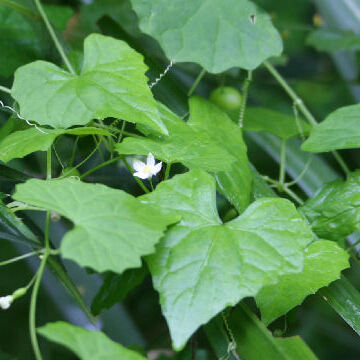Plants scandent. Stems and branches filiform, glabrous. Petiole slender, 2.5-3.5 cm, villous at first, glabrescent; leaf blade abaxially pale green, adaxially dark green, polymorphic, triangular-ovate, ovate-cordate, or hastate, 3-5 × 2-4 cm, membranous, unlobed or 3-5-lobed, abaxially glabrous, adaxially scabrous, apex acute or rarely shortly acuminate. Plants monoecious. Male flowers solitary, or 2 or 3 in a raceme; peduncle slender, very short, glabrous; pedicels filiform, 3-5 mm, glabrous; calyx broadly campanulate, ca. 1.5 mm, base acute or obtuse; corolla pale yellow, puberulent; segments oblong or ovate-oblong, 2-2.5 × 1-1.5 mm; stamens 3, two 2-celled and one 1-celled, sometimes all 2-celled; filaments short, ca. 0.5 mm; anthers ovoid-oblong or oblong, ca. 1 mm, pubescent; anther cells curved, puberulent; connective broad, apex produced. Female flowers solitary or rarely paired in same axil as male flowers; pedicel filiform, 1-2 cm, glabrous; corolla broadly campanulate, ca. 2.5 mm in diam.; segments lanceolate, 2.5-5 × 1-1.5 mm, apex slightly obtuse; ovary narrowly ovoid, 3.5-4 × 1-2 mm; style short, ca. 1.5 mm; stigmas 3; staminodes glandular. Fruit orange or red, oblong or attenuately ovoid, 1-1.5 cm × 5-8(-10) mm, both ends obtuse. Seeds gray-white, ovate, 3-5 × 3-4 mm, base attenuate, margin obscure. Fl. Apr-Jul, fr. Jul-Oct.
More
A pumpkin family plant. It is a fine climbing plant. It has fleshy thickened roots. There are fine hairs underneath the stems. The stems are much branched and 1-2 m long. The tendrils are not branched. The leaves are oval or triangle shaped and 3-8 cm long. They taper to the tip and have lobes at the base. They are irregularly rounded or scalloped along the edge. The flowers are white and of one sex but with both sexes on the same plant. They are 5 mm across. The fruit are oval and 1-2 cm long. The fruit are whitish berries.

